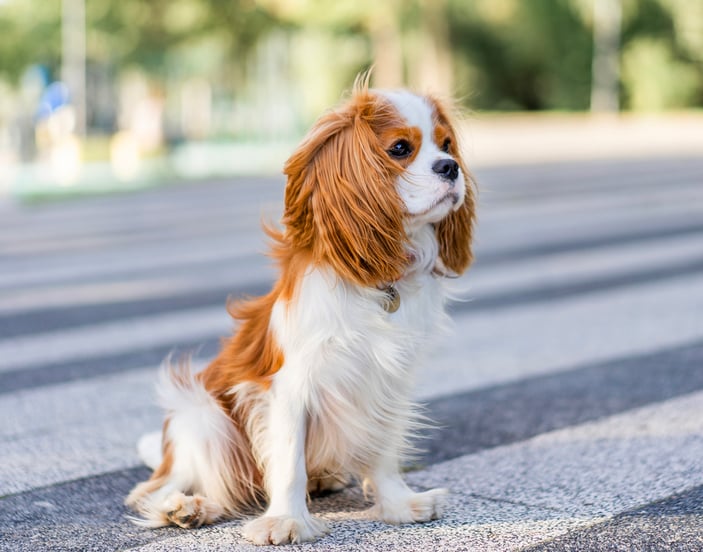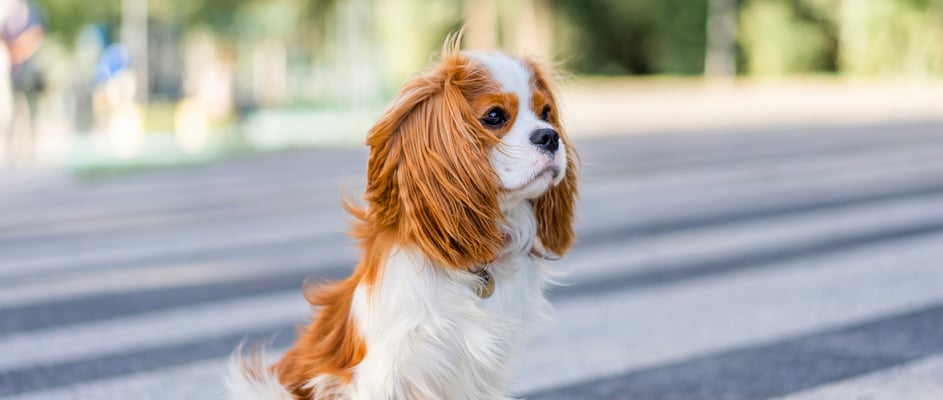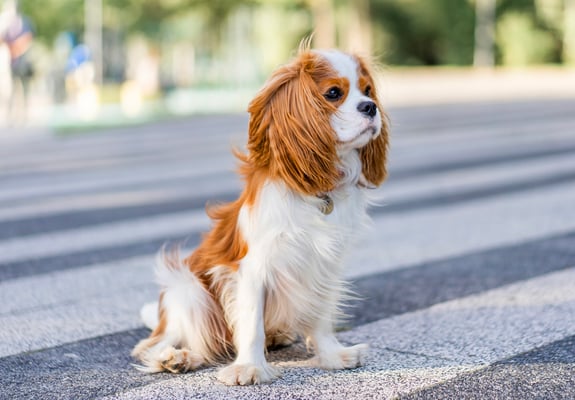The guide to owning a Cavalier King Charles Spaniel.
Want to know everything there is to know about training your Cavalier King Charles Spaniel puppy? Submit your email below, and we’ll send you a one-stop guide on all things puppy training!
Jump to:
Stats at a glance.
A history of the Cavalier King Charles Spaniel.
Meet the Cavalier King Charles Spaniel – a gentle, loving dog breed that traces its roots back centuries. This small yet royally connected pup owes its name to Charles II, the monarch who adored his Cavalier dogs so much that he reportedly decreed they should be allowed in any public place (including Parliament!).
If you look even further back, you’ll discover Charles I and his son both loved these toy Spaniels, and it’s believed their fondness for Spaniels helped shape the breed’s popularity.
King Charles Spaniels were bred for companionship, making them loyal lap dogs for British nobility. Over time, the Cavalier King Charles Spaniel club emerged to preserve the original appearance of Spaniels of the old type – the ones with a longer muzzle and flatter skull.
This dedication to tradition gave us the Cavalier King Charles Spaniel dog we know and love today.
Though often associated with aristocrats and castles (some say Blenheim palace played a role in shaping the Blenheim Cavalier king Charles coat markings), these affectionate pups found their way into everyday homes all around the world.
They remain one of the most popular dog breeds, beloved for their sweet demeanour, expressive eyes, and adorable silky ears.
Want to explore other small canines adored by families? Check out our guide to the Top 10 Small Breeds for more ideas!
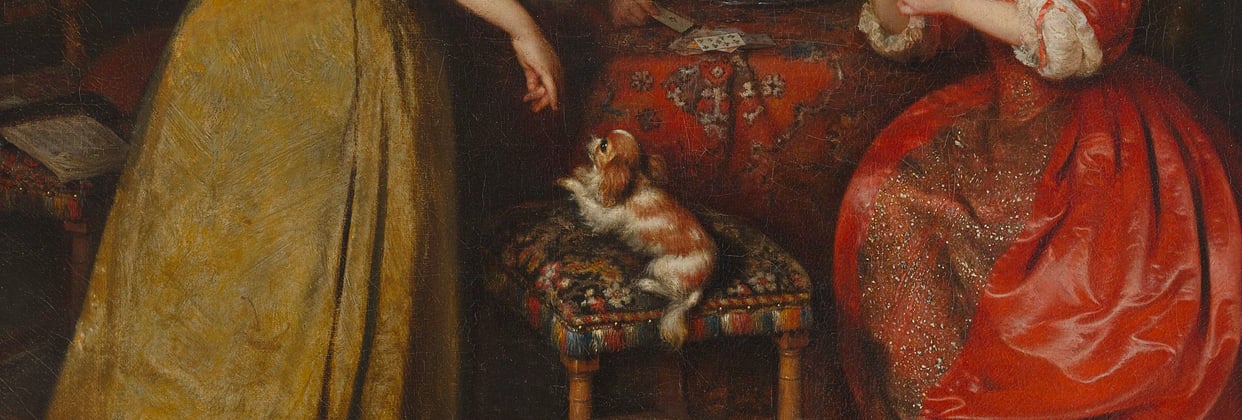

How much is a Cavalier King Charles Spaniel puppy (UK)?
Thinking of buying a Cavalier or adding one to your household? You’ll likely want to know the costs involved. In the UK, Cavalier King Charles Spaniel puppies typically range from £800 to £2,500. Several factors can influence that price:
Pedigree: Purebred dogs or those from champion lines may cost more.
Coat Colour and Patterns: Certain colours, like Blenheim, can be in higher demand.
Reputable breeder status: A responsible breeders network invests in health tested parents and top-notch care for the litter.
If you’re new to getting a Cavalier, don’t forget to read our Advice: Buying a Dog article to know what questions to ask, what health checks to look for, and how to spot warning signs of a less reliable source.
What to look for in a responsible breeder.
They show genuine care and interest in where their puppies for sale are going.
They let you meet the adult dog parents and check for health information (like heart screenings for mitral valve disease).
They provide the right paperwork such as breed club or kennel club registrations and a register of puppies.
They gladly answer all your questions on breed health, potential health problems, and responsible ownership.
Colours and coat types.
The Cavalier King Charles Spaniel’s coat comes in four main colours, each equally gorgeous and part of the breed standard:
Blenheim Cavalier: Chestnut markings on a pearly white background, often sporting the famous “Blenheim spot” on the forehead.
Tricolour: Black, white, and tan patterning.
Black and Tan: Shiny black coat with tan highlights above the eyes, on the cheeks, chest, and legs.
Ruby: Rich red all over.
These toy Spaniels sport a soft, silky coat of moderate length. Their luxurious ears and feathering give them a regal look. Regular brushing helps maintain that plush texture and reduce tangles, especially around the ears and legs.





Size and weight.
As a small dog breeds category member, the Cavalier King Charles Spaniel dog usually stands around 30-33cm at the shoulder and weighs between 5-8 kg. Though petite, they carry themselves with elegance and poise.
Curious about how other breeds measure up? Take a peek at our Big Dog Breeds UK post for a contrast in size and temperament.
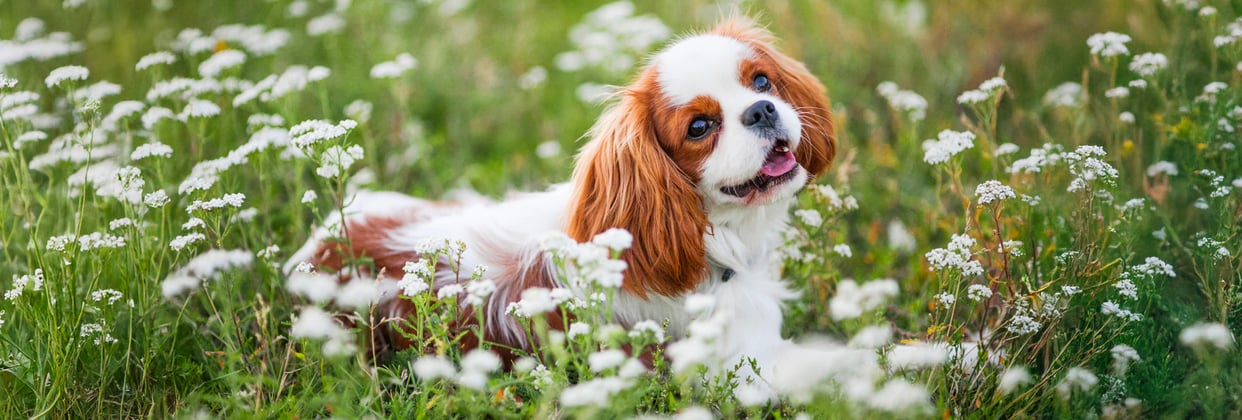

Temperament and Behaviour.
Don’t be fooled by their fancy name. Cavalier King Charles Spaniels may act like royalty, but they’re also some of the most down-to-earth, friendly family dogs around.
They’re known for their adaptability, eager to please approach to training, and gentle nature with kids and older folks alike.
Personality.
Affectionate: These pups thrive on human companionship. They’ll become your favourite shadow, following you from room to room.
Sociable: They often get along well with other dogs and can do fine with cats if introduced properly.
Easy to train: Because a Cavalier is so eager to make you happy, they generally respond well to positive reinforcement.
Playful: Expect a moderate energy level, with bursts of zoomies around the house balanced by contented snuggle sessions.
Do Cavalier King Charles Spaniels make good pets?
Absolutely! Owning a Cavalier king Charles means welcoming a sweet, people-oriented dog into your family.
They’re often recommended as first-time pets for individuals or families who want a small, loving companion.
However, they do need plenty of attention. Like other companion or lap dogs, they dislike being left alone for too long. If your lifestyle involves long work hours, it’s important to plan for dog-walkers or doggy daycare, so your pup’s social needs are met.
If you’d like to see which breeds also fall under “great family pets,” check out our Best Dog Breeds for First-Time Owners blog.
Are Cavalier King Charles Spaniels good with kids?
In most cases, yes. Cavaliers are gentle, affectionate, and eager to play. Because they’re a smaller breed, though, it’s wise to teach children how to handle them carefully. Large or boisterous kids can accidentally injure a Cavalier puppy.
Tips for kids and Cavaliers:
Encourage calm interactions.
Teach children not to pull ears or tails.
Always supervise play with younger kids.
Make sure your Cavalier has a safe, quiet spot to retreat to.
Are Cavaliers good with cats?
Many Cavalier King Charles Spaniel dog owners report harmonious relationships between their Spaniel and the resident feline. Early, positive introductions are key. Cavaliers don’t have the intense prey drive some other Spaniels do, but each individual dog is unique.
If you’re wondering about other cat-animal relationships, you might find some interesting insights in our article Do Foxes Attack Cats? (spoiler: protecting your cat is often about supervision and environment).
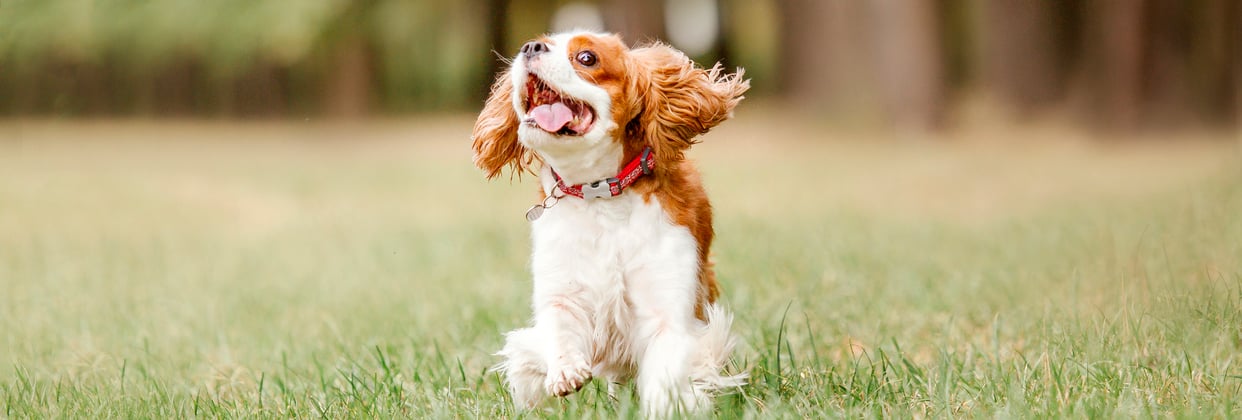

Behaviour.
Do Cavalier King Charles Spaniels suffer from separation anxiety?
Because they form strong bonds, leaving your Cavalier alone for hours can result in anxious behaviours such as whining or destructive chewing. If you need to step out regularly, consider:
Hiring a dog walker or pet sitter.
Dog daycare (a chance to socialise safely).
Gradual desensitisation training to build independence.
Anxious pups aren’t alone in the dog world. For extra support, visit our blog on Separation Anxiety to learn strategies for comforting your companion.
Can Cavaliers be left alone?
They can, but not for too long. Most experts advise no more than four to six hours. They’re so family-oriented that extended solitude can bring on stress, depression, or even harmful habits. Always never leave your dog for excessive periods without a plan – whether that’s a friend dropping in, a professional walker, or an interactive toy to keep them company.
Do Cavaliers bark a lot?
In general, Cavalier King Charles Spaniels bark less than some other small breeds. They were bred more for companionship than for guarding. Of course, every dog is an individual, but most Cavaliers only bark to alert you to something unusual or to get your attention.
Training a Cavalier King Charles Spaniel.
Are they smart? Yes, but it’s a soft, gentle intelligence best nurtured through reward-based methods. They’re dogs that are eager to learn, but harsh corrections can quickly shut them down. Keep sessions short, positive, and filled with praise or treats.
Socialisation: Start from puppyhood. Introduce new sights, sounds, and surfaces.
Short sessions: 10-15 minutes at a time, using positive reinforcement.
Consistency: Stick to routine cues like “sit,” “stay,” or “come.”
Fun breaks: This breed isn’t made for intense, militaristic training. Make it fun with games.
Looking for helpful techniques? Check out our blog post on essential Cocker Spaniel training tips. Many of those positive reinforcement methods also work for Cavalier puppies because the learning patterns are similar among Spaniels.
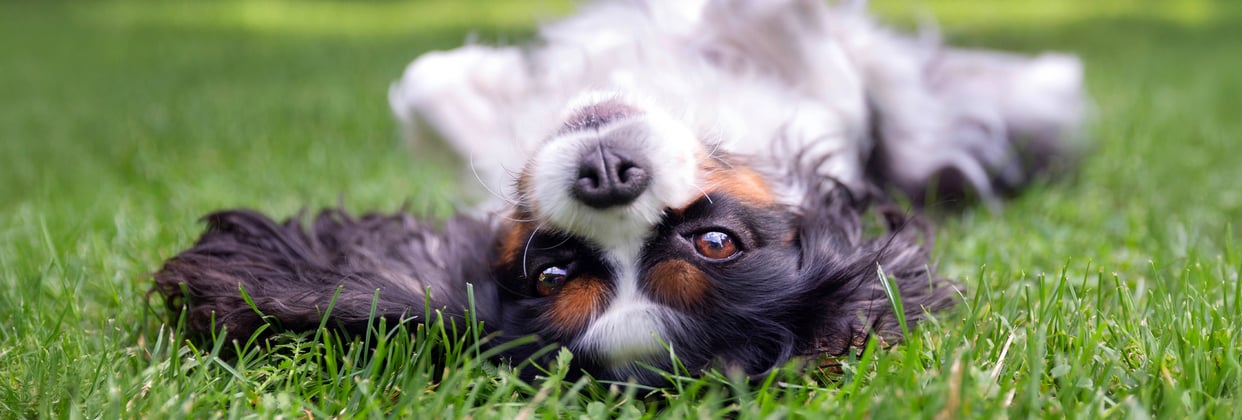

Shedding and grooming.
Do Cavalier King Charlies Spaniels shed? Yes. Cavaliers have a silky coat that does shed moderately throughout the year. Regular brushing can help keep hair under control. Set aside time a few times each week to comb and remove loose fur.
Basic grooming checklist
Brushing: 3-4 times a week with a soft slicker brush or comb.
Bathing: Once every month or two, or as needed. Cavaliers can have sensitive skin, so use a mild shampoo.
Ears: Check and clean weekly. Long, floppy ears can trap moisture, leading to infections. Our guide to How to Clean Your Dog’s Ears Safely and Effectively can help.
Nails: Trim every 3-4 weeks if not worn down naturally.
Teeth: Regular brushing helps prevent tartar buildup and gum issues.
Exercise and mental stimulation.
Cavalier King Charles Spaniels aren’t extreme athletes, but they do need daily walks and interactive play. An adult Cavalier usually enjoys about 20-40 minutes of moderate exercise per day. For puppies, shorter, more frequent sessions are recommended to protect their joints.
Things to remember
Low impact: Jumping off furniture or sprinting on hard surfaces can stress joints and backs.
Play time: They love retrieving soft toys or playing gentle tug. A local dog park might be fun if your pup is social, but always supervise their interactions.
Mental enrichment: Puzzle feeders, treat-dispensing toys, or short training drills keep that eager mind engaged.
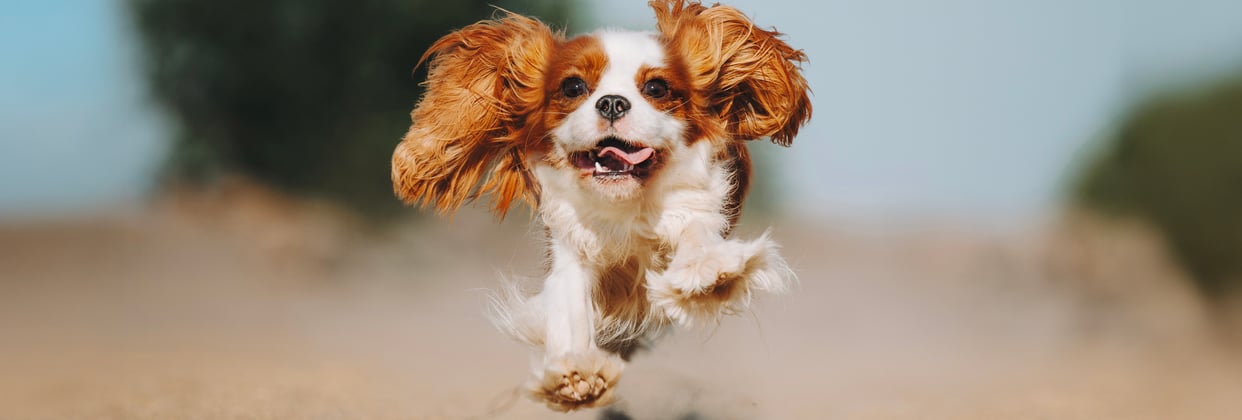

Feeding and nutrition.
Good nutrition is vital to keep your dog happy and healthy. Cavalier King Charles Spaniels need high-quality dog food tailored to their life stage (puppy, adult, or senior). Look for brands that list meat or fish as the first ingredient, and be mindful of portion sizes to prevent obesity.
Daily feeding guideline (Adult)
1 to 1.5 cups of balanced kibble per day, split into two meals.
Adjust based on activity level and your veterinary recommendations.
If your Cavalier is a picky eater or shows signs of allergies, a vet consultation is the best approach. Some prefer wet or home-cooked diets. Just be sure to include essential nutrients.
Common health issues.
One of the reasons people love Cavaliers so much is their gentle nature. However, like any pedigree dog, they’re prone to several health conditions. Understanding them helps you be proactive.
Below are three main health issues currently – or historically – screened for in Cavaliers:
Mitral valve disease (MVD)
A heart murmur or irregular heartbeat due to a leaky valve can lead to congestive heart failure. Cavaliers are notably prone to certain health issues like MVD, so regular cardiac checks are crucial.
Cost: Initial diagnosis (ultrasound and x-rays) can cost £400-£1,000. Ongoing medications and check-ups might run £50-£100 per month.
Syringomyelia
A neurological condition where fluid-filled cavities develop in the spinal cord. This can cause pain, scratching at the neck or ears, and even mobility issues.
Cost: MRI scans range from £1,500-£2,500. Medications or surgeries vary widely, from a few hundred to a few thousand pounds.
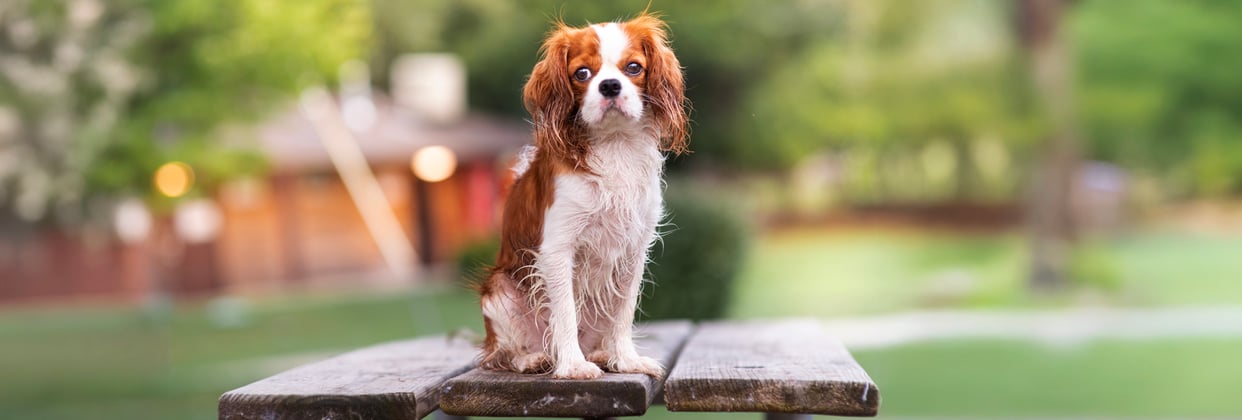

Hip dysplasia
Though smaller breeds are less likely to suffer severely, some Cavaliers can experience malformation of the hip joints, leading to discomfort and potential arthritis.
Cost: Conservative management (physiotherapy, pain relief) may be £200-£500. Surgery can cost £2,000-£5,000 per hip.
Other health problems or common health problem concerns include:
Episodic falling: A rare condition causing muscle stiffness and collapse, typically triggered by excitement or exercise. This can cost anywhere from £50-£80 to diagnose, with ongoing medication costs for treatment varying.
Dry eye: Also known as keratoconjunctivitis sicca, where inadequate tear production causes irritation. Treatment can cost between £10-£20 per eye.
Potential health risks: like obesity if overfed.
Remember, older dogs may need extra check-ups to watch for age-related issues. A trusted vet is your best partner for diagnosing and managing these health conditions.
Pet insurance for Cavalier King Charles Spaniels.
Given these potential health problems, having comprehensive coverage isn’t just sensible—it’s a real lifesaver. Imagine facing costly surgery for mitral valve disease or neurological testing for syringomyelia without any financial cushion. Pet insurance can make a world of difference.
At Waggel, we:
Offer lifetime pet insurance.
Offer 24/7 online vet access via our Joii platform.
Provide free behaviour and nutrition consultations for those training or diet challenges.
Give you an intuitive claims process—no confusing jargon.
